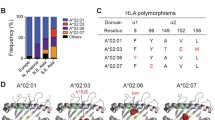Summary
Results of a follow up study on ADCC and CMC to HBs antigen conjugated target cells in patients with hepatitis B are given. The cytotoxic reaction was measured immediately after onset of the disease, three weeks and three months thereafter. CMC was increased over the whole observation period. The results in hepatitis B patients were significantly different to those in normal controls. The ADCC in the presence of an antiserum to HBs antigen was in patients with hepatitis B immediately after onset of the disease reduced in comparison to the controls; it increased during the three months to the values of the controls in patients with uncomplicated disease. Experiments with isolated lymphocyte populations showed that the ADCC is mainly dependent on Fc receptor bearing lymphocytes whereas the CMC is mediated by T-cells and Fc-receptor bearing cells.
Zusammenfassung
Es wurden die antikörperabhängige zellvermittelte Zytotoxizität (ADCC) und die zellvermittelte Zytotoxizität (CMC) bei Hepatitis B-Patienten gegen HBs-Antigen gekoppelte Targetzellen im Sinne einer Follow-up-Studie untersucht. Die Messung der zytotoxischen Reaktionen erfolgte unmittelbar nach Ausbruch der Erkrankung, sowie drei Wochen und drei Monate nach Ausbruch der Hepatitis B. Dabei zeigte sich, daß die CMC während des Beobachtungszeitraumes etwa gleichbleibend erhöht ist. Gegenüber der Kontrollpopulation war sie eben signifikant verschieden. Die ADCC in Gegenwart von Antiserum gegen HBs-Antigen unmittelbar nach Ausbruch der Erkrankung war im Vergleich zu den Kontrollpersonen deutlich reduziert und zeigte im Verlauf von drei Monaten nach komplikationslosem Verlauf der Hepatitis B einen Wiederanstieg. Die Werte für die ADCC der Patienten mit Zustand nach Hepatitis B entsprachen denen der Kontrollpersonen. Aufgrund von Untersuchungen mit isolierten Zellpopulationen ist die ADCC-Reaktion weitgehend auf die Fc-Rezeptor tragenden Lymphozytenfraktion zu beziehen, während an der CMC T-Zellen und Fc-Rezeptor tragende Zellen Anteil haben.
Similar content being viewed by others
Literatur
Böyum A (1968) Isolation of mononuclear cells and granulocytes form human blood. Scand J Clin Lab Invest 21:77
Campbell DH, Garvey JS, Cremer NE, Sussdorf DH (1970) Methods in Immunology. Campbell DH (ed), WA Benjamin, Inc, New York, p 282
Cerottini JC, Nordin AA, Brunner KT (1971) Cellular and humoral response to transplantation antigens. J Exp Med 134:553
Chisari FV, Routenberg JA, Edington TS (1976) Mechanisms responsible for defective human T-lymphocyte sheep virus infection. J Clin Invest 57:1227
Cohen AM, Millar RC, Detcham AS (1972) A microassay for cytotoxic antibody using125I-iododeoxyuridin labelled target cells. Transplantation 13:57
Horatius RJ de, Strickland RG, William RC (1974) T-and B-lymphocytes in acute and chronic hepatitis. Clin Immunol Immunopathol 2:353
Fridman WH, Goldstein P (1974) Immunoglobulin binding factor present on and produced by thymusproceeded lymphocytes (T-cells). Cell Immunol 11:442
Jondall M, Pross H (1975) Surface markers on human B- and T-lymphocytes. VI. Cytotoxicity against cell lines as a functional marker for lymphocyte subpopulations. Int J Cancer 15:596
Lay WH, Mendes NF, Bianco C, Nussenzweig V (1971) Binding of sheep red blood cells to a large population of human lymphocytes. Nature 230:531
MacLennan ICM (1972) Antibody in the induction and inhibition of lymphocyte cytotoxicity. Transplant. Rev. 13:67
Perlmann P, Perlmann H, Wigzell H (1972) Lymphocyte mediated cytotoxicity in vitro. Induction and inhibition by humoral antibody and nature of effector cells. Transplant Rev 13:91
Shearer GM, Rhen TG, Carbarina CA (1975) Cell-mediated lympholysis of trinitrophenol-modified autologous lymphocytes. J Exp Med 141:1348
Warnatz H, Rösch W, Gerlich W, Gutmann W (1979) Antibody-dependent cell-mediated cytotoxicity (ADCC) and cell-mediated cytotoxicity (CMC) to HBs-Ag-coated target cells in patients with hepatitis B and chronic hepatitis (CAH). Clin Exp Immunol 35:133–140
Zinerknagel RM, Doherty PC (1974) Restriction of in vitro T-cell mediated cytotoxicity in lymphocytic chriomeningitis within a syngencic or semi-allogeneic system. Nature 24:170
Author information
Authors and Affiliations
Additional information
Mit Unterstützung der Deutschen Forschungsgemeinschaft (Forschungsvorhaben Wa 234/8)
Rights and permissions
About this article
Cite this article
Warnatz, H., Gerlich, W., Gutmann, W. et al. Antikörperabhängige zellbedingte Zytotoxizität (ADCC) und zellvermittelte Zytotoxizität (CMC) gegenüber HBs-Antigen gekoppelten Targetzellen bei Patienten mit Hepatitis B. Klin Wochenschr 58, 1251–1255 (1980). https://doi.org/10.1007/BF01478931
Received:
Accepted:
Issue Date:
DOI: https://doi.org/10.1007/BF01478931
Key words
- Antibody dependent cell mediated cytotoxicity
- Cell mediated cytotoxicity to HBs-antigen conjugated target cells
- Hepatitis B follow up study over three months



